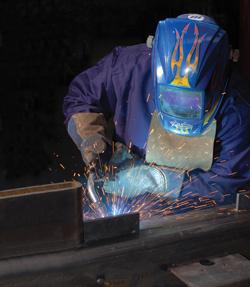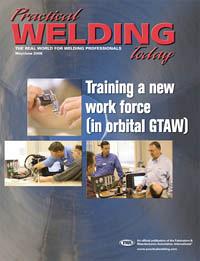Research and Design Engineering Manager
- FMA
- The Fabricator
- FABTECH
- Canadian Metalworking
Categories
- Additive Manufacturing
- Aluminum Welding
- Arc Welding
- Assembly and Joining
- Automation and Robotics
- Bending and Forming
- Consumables
- Cutting and Weld Prep
- Electric Vehicles
- En Español
- Finishing
- Hydroforming
- Laser Cutting
- Laser Welding
- Machining
- Manufacturing Software
- Materials Handling
- Metals/Materials
- Oxyfuel Cutting
- Plasma Cutting
- Power Tools
- Punching and Other Holemaking
- Roll Forming
- Safety
- Sawing
- Shearing
- Shop Management
- Testing and Measuring
- Tube and Pipe Fabrication
- Tube and Pipe Production
- Waterjet Cutting
Industry Directory
Webcasts
Podcasts
FAB 40
Advertise
Subscribe
Account Login
Search
Filler metal product approvals
What do they mean?
- By Joe Bundy
- May 13, 2008
- Article
- Consumables
At one time or another you've probably browsed the contents of a filler metal specification sheet. Listed, of course, is the standard data—available wire or electrode diameters, product characteristics, features and benefits, operating parameters, and shielding gas requirements. In short, all the information you need to weld properly with that filler metal.
Also listed is a section with a rather enigmatic title: "Conformances fand Approvals" (sometimes called specifications).
In this section filler metal manufacturers list the product approvals that the wire or electrode bears according to an agency such as the American Welding Society (AWS), American Society of Mechanical Engineers (ASME), American Bureau of Shipping (ABS), Det Norske Veritas (DNV), Lloyd's Register, or the Canadian Welding Bureau (CWB).
Gaining and listing a product approval from one of these regulatory agencies signifies the filler metal manufacturer's commitment to quality and safety. It means its product is proven to yield specific mechanical and chemical properties as needed for critical applications like structural steel erection, shipbuilding, offshore platforms, and petrochemical piping.
Understanding the research, development, and testing that filler metals undergo to meet the requirements of these agencies can be difficult, but knowing the basics of what the resulting product approvals signify doesn't have to be.
Familiar Territory? A Look at AWS and Similar Product Approvals
AWS does not provide product approvals per se, but rather the agency sets forth standards to which filler metals need to conform.
To begin, AWS provides specifications for filler metals. A specification refers to a group of filler metals that has been formulated for welding on a particular base material, such as AWS 5.20 (fully, AWS 5.20/5.20M:2005), which is "Specifications for Carbon Steel Electrodes for Flux-Cored Arc Welding." For every type of material, electrode, wire, and welding process, AWS sets forth similar specifications.
Within each AWS specification are multiple AWS classifications, standards to which filler metal manufacturers develop their products. Each classification bears an alphanumeric formula that represents specific mechanical and chemical properties. The classification also provides important information on how the filler metal should be used to ensure the stated weld properties are achieved.
For example, within the AWS A5.20 specification is a flux-cored wire with the AWS classification E71T-1C H8. Following is a breakdown of each component of that classification:
E = Electrode
7 = Wire tensile strength measured in pounds per square inch (PSI); in this case, 70,000 PSI
The first 1 = All-position welding capability. (Note: 2 would indicate flat/horizontal welding position capabilities)
T = Tubular wire, specifically, flux-cored. AWS uses a C to refer to metal-cored wires
The second 1 = Wire usability, including that this wire has a rutile slag system and operates on electrode positive (DCEP)
C = Wire requires a CO2 shielding gas. (M would be listed for a wire that requires an argon/CO2 shielding gas mixture)
H8 = How much diffusible hydrogen is in the weld metal. In this example, there is less than 8 ml of hydrogen per 100 g of deposited weld metal (Note: The lower the number, the less hydrogen and the lower the chance for hydrogen-induced cracking in the final weldment)
Labeling a filler metal with an AWS classification is the manufacturer's promise of quality. It means that it has created a product that provides the weld properties its classification requires under standardized test conditions. However, AWS does not inspect or witness testing.
An AWS classification is also a guideline that dictates filler metal selection for critical welding applications. For instance, the AWS fabricating code D1.1 dictates the design and welding requirements for structural steel. But it also determines acceptable filler metals for the job. By way of example, the AWS A.520-specified E71T-1C H8 classification discussed thus far would be suitable for certain applications under the AWS D1.1 code.
An example would be the welding of Group II steel, such as A572 grade 50, A36, or A992 used on structural beam or column splices. It is generally the duty of the engineer of record or a certified welding engineer involved with fabrication to obtain a certificate of conformance (also called a C of C or a typical cert) as evidence that a particular filler metal meets a certain specification and classification.
AWS is not the only agency that requires filler metals to conform to certain properties. In fact, the ASME uses nearly the same nomenclature for its product approvals. For example, the "Specifications for Carbon Steel Electrodes for Flux-Cored Arc Welding," designated by AWS A.520, would be listed under ASME standards as ASME SFA5.20. ASME also prescribes a set of fabricating codes that dictate what filler metals are required for critical applications. Like AWS codes, these are designed to ensure filler metal quality and the overall safety of the structure or components being welded.
Keeping Filler Metals Safe for Land and Sea
The ABS is an organization with the primary function of overseeing the production of marine vessels and offshore platforms. However, it also governs product approvals for filler metals that are acceptable to use on these applications.
For a filler metal manufacturer to obtain ABS product approval, it must regularly have its products audited for quality, which includes an on-site visit to view production and to conduct weld testing. Upon successful completion of that testing, ABS then certifies the product to what is called a grade.
For the previous AWS E71T-1C H8 flux-cored wire example, ABS could provide a product approval of ABS Grade 2SA or 2YSA. Like AWS classifications, these grades can again be broken down according to mechanical and chemical properties:
2 = Impact strength or toughness at a given temperature (also called Charpy V-notch). Here, that temperature is -20 degrees C, or -4 degrees F (Note: A 3 would indicate -30 degrees C, or -22 degrees F and a 4 would indicate -40 degrees C, or -40 degrees F)
SA = Wire can be used in a semi-automatic welding process. (Note: A semiautomatic approval also encompasses an automatic welding process approval)
When present, Y indicates the filler metal provides high yield strength (over 50,000 PSI)
Similar to ABS are Lloyd's Register and DNV. Both agencies oversee shipbuilding, oil and gas pipelines, and energy structures worldwide, as well as provide product approvals of filler metals for these applications. Lloyd's especially tends to oversee product approvals for consumables used in structures in Europe. DNV commonly oversees the development of platforms intended for the North Sea and, with this construction, filler metals that are capable of producing welds to withstand the extreme cold temperature of that water.
Lloyd's Register lists its product approvals using a similar system as ABS. As in the running example of the AWS E71T-1C H8 filler metal, this wire could have Lloyd's approval of 3Y40S H10.
3 = Impact strength at a given temperature, which in this example is -30 degrees C, or -22 degrees F Y40 = Tensile strength in megapascals (MPa), the metric version of PSI. Here it is 400 MPa
S = Wire is designed for semiautomatic welding
H10 = Amount of diffusible hydrogen, in this case 10 ml per 100 g of weldment
A DNV product approval for this wire could be DVN II YMS, and the formula's breakdown is similar to that of other agencies' formulas.
II = Impact strength at a given temperature, which here is -20 degrees C, or -4 degrees F
Y = Wire's high yield strength
M = Wire can be used for multirun welding
S = Wire can be used for semiautomatic applications
Like its American counterpart, the CWB has distinct requirements that must be met for a filler metal to bear its product approval. That approval, like one from AWS, comes in the form of a classification. CWB also provides specifications for families of filler metals, along with codes for fabrication and filler metal selection.
A product approval or CWB classification for a carbon steel flux-cored wire similar to the previous example could be labeled E491T-9 H8:
E = Electrode
49 = Tensile strength in MPa (in this case, 490 MPa, or about 70,000 PSI)
1 = Wire has all-position welding capabilities
T = Tubular wire
9 = Wire offers low-temperature impact values (to -30 degrees C, or -22 degrees F)
H8 = Wire has 8 ml of diffusible hydrogen per 100 g of weldment
Again, for a filler metal manufacturer to gain a product approval from CWB, its products must undergo testing on a regular basis. CWB requires testing every two years, while some of the other agencies require annual testing for a filler metal to continue bearing its product approval.
Whichever the testing frequency, the goal is the same: to ensure quality and safety. When the filler metal you choose bears a specific product approval or states that it conforms to a particular standard, you can be assured that it does.
About the Author
About the Publication
subscribe now

The Welder, formerly known as Practical Welding Today, is a showcase of the real people who make the products we use and work with every day. This magazine has served the welding community in North America well for more than 20 years.
start your free subscription- Stay connected from anywhere

Easily access valuable industry resources now with full access to the digital edition of The Fabricator.

Easily access valuable industry resources now with full access to the digital edition of The Welder.

Easily access valuable industry resources now with full access to the digital edition of The Tube and Pipe Journal.
- Podcasting
- Podcast:
- The Fabricator Podcast
- Published:
- 04/16/2024
- Running Time:
- 63:29
In this episode of The Fabricator Podcast, Caleb Chamberlain, co-founder and CEO of OSH Cut, discusses his company’s...
- Trending Articles
Sheffield Forgemasters makes global leap in welding technology

ESAB unveils Texas facility renovation

Engine-driven welding machines include integrated air compressors

How welders can stay safe during grinding

The impact of sine and square waves in aluminum AC welding, Part I

- Industry Events
16th Annual Safety Conference
- April 30 - May 1, 2024
- Elgin,
Pipe and Tube Conference
- May 21 - 22, 2024
- Omaha, NE
World-Class Roll Forming Workshop
- June 5 - 6, 2024
- Louisville, KY
Advanced Laser Application Workshop
- June 25 - 27, 2024
- Novi, MI



























